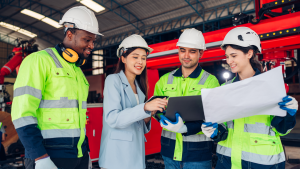Requirement 7.5 Documented Information in ISO 14001:2015 does not differ much from what is stated in other standards. Generally, it establishes requirements for creating, maintaining, and controlling documented information in an Environmental Management System (EMS).
It is worth noting that “documented information” refers to any type of information that needs to be controlled and maintained by the organization, whether in the form of documents or records.
Furthermore, it is also important to emphasize that the objective of documented information, according to ISO 14001:2015, is to ensure the effectiveness of the EMS. To achieve this, the company needs to establish, implement, and maintain the necessary documented information while ensuring appropriate availability, integrity, and accessibility for its use.
As examples of documented information related to environmental management and EMS, we can mention environmental policies, standard operating procedures (SOPs), work instructions, action plans, environmental monitoring records, evidence of legal compliance (which is highly relevant), among other types of documents and records.
The relationship between legal compliance and EMS documentation
Just like in any other management system (quality, occupational health and safety, information security, etc.), documentation is essential for maintaining operations and continuous improvement.
However, regarding environmental management, it is important to highlight that documentation also plays a crucial role in keeping the company within the parameters of the law. This is because certain contexts are much more sensitive and can cause more significant environmental impacts. In such cases, there are higher levels of governmental regulation, and violating these principles can result in fines, reputational damage, and various losses for the companies.
Therefore, it is important to identify and ensure the validity of various documents and records. Among them, we can mention environmental licenses and permits, compliance and monitoring reports, environmental management plans, environmental impact assessments, and many other types of documented information.
It is important to remember that each organization has its own needs and degree of environmental impact. As a result, each company will need to establish, implement, and maintain specific documented information. This not only helps ensure legal compliance but also improves the overall functioning of the company.
What documented information is necessary?
As already emphasized, each organization has its own needs, so it is not possible to provide an exhaustive list of the necessary documented information.
However, for guidance, ISO 14004:2015 provides “Practical Help Box 19.” It contains best practices and documented information that companies should consider maintaining in their environmental management system. These include:
- – Scope of the EMS;
- – Environmental policy;
- – Identified risks and opportunities;
- – Environmental aspects and impacts;
- – Environmental objectives;
- – Competence records;
- – Evaluation and monitoring results;
- – Among various other types of documents and records.
While the suggestions in Practical Help Box 19 are illustrative, it is worth consulting the document. It can help companies better understand their documented information and grasp the appropriate extent of requirement 7.5 Documented Information in ISO 14001:2015.
Updating the documented information of the EMS
Updating and controlling documented information are two important points of attention in environmental management (and any other management system).
Since the operational context of companies is constantly changing, documents need to be periodically reviewed to ensure they are up to date and remain relevant.
Correctly updating processes, procedures, and work instructions, for example, is essential for the smooth running of QMS activities.
It is also advisable to record certain changes and make them available if needed. Furthermore, it is important to communicate these changes to relevant stakeholders whenever necessary.
Controlling relevant documented information
Access to EMS documents must be ensured for those who need them while preserving their legibility and integrity and implementing effective version control. However, there are various pieces of information that may be more or less sensitive and may not be available to everyone.
Therefore, it is necessary to have a system that ensures the availability of information only to those who are authorized to access it. Additionally, the documents should be available in an appropriate location and in a readable format. Any employee who needs to access these documents should be able to find them easily and understand their content.
Similarly, it is important for all these documents to be traceable, ensuring greater transparency, security, and accuracy of the company’s documented information, as well as facilitating legal compliance. This is particularly important in facilitating the identification of evidence during internal and external audits, as it aids in understanding and locating information.
Promoting a culture of environmental excellence through documented information
Documented information plays a crucial role in both the success of the Environmental Management System (EMS) and the pursuit of ISO 14001 certification. By organizing, integrating, and maintaining documented information appropriately, companies can achieve a range of benefits and improve their overall performance.
Documented information is vital to ensure the effectiveness of the EMS, providing guidelines, operational procedures, and records that document the organization’s environmental performance. Additionally, it plays a crucial role in legal compliance, ensuring that the company complies with environmental regulations and avoids fines and reputational damage.
In summary, documented information is a powerful tool for environmental management and achieving ISO 14001 certification. By promoting organization, integration, and consistency of documented information, companies can improve their environmental performance, make evidence-based decisions, and achieve legal compliance.











